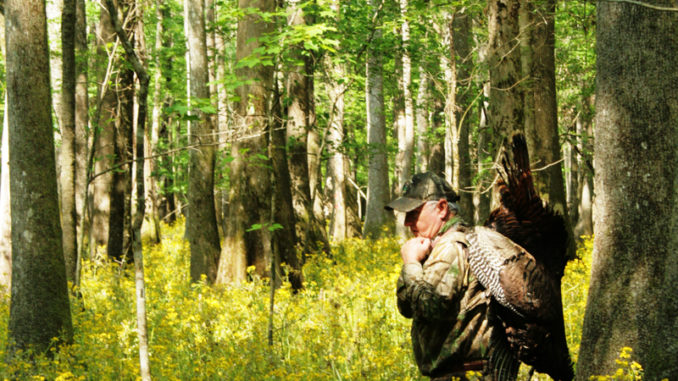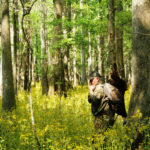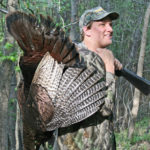
With turkey season extending into May for the first time, South Carolina hunters need to know exactly how to deal with pressured, late-season gobblers.
Having turkey season extend into May offers some late-season opportunities for turkey hunters in the Palmetto State, but how much will hunters take advantage of it? Hunter numbers seem to dwindle late in the season, based on the absence of vehicles parked at gates and along roads in areas with good turkey habitat. Places that were packed in late March and the first half of April often become increasingly hunter-free by late in the season.
But according to some gobbler gurus, that doesn’t mean hunting success ends. Some hunters understand that extending the season through May 5 means even more time to get after these late-season birds.
Skeet Thomas of Chester chases gobblers nearly every day of the season, and his passion to work a bird doesn’t diminish because the calendar rolls into late April and early May.
“I love late-season turkey hunting and have found plenty of success during that part of the season,” Thomas said. “No doubt most gobblers have been pressured, and that impacts their behavior, but I’ve found plenty of gobblers willing to work a call, and work it well, late in the season.”
Thomas, 59, splits his time out of the woods selling insurance and pastoring a church in Chester County. He began turkey hunting in 1975, and by 1979, he was entering calling contests. He won five South Carolina state titles and numerous other open calling championships around the country before he stopped competitive calling in 1995.
“Now, I focus on just calling turkeys,” he said.
Thomas said it essential to understand what’s happening to successfully hunt turkeys late in the season. Part of the puzzle is where they are in the breeding and nesting process.
“Early in the season, it’s about breeding, and hens and gobblers are usually together or getting together,” he said. “Later in the season as hens are bred and begin to sit nests, the pattern changes, and fewer hens are available to gobblers. This impacts gobblers and is important to strategy. I exploit the fewer-hens-available situation as my ally. The gobblers have been pressured, but fewer available hens and still-willing gobblers create a great opportunity.”
Thomas said late-season success depends on several factors, one of which is calling ability.
“I am a firm believer that making the right sounds in the right way is your best late-season ally,” he said. “I think a great caller who’s a good woodsman will kill more turkeys than an average caller who’s a great woodsman. Work on making your calls sound like a real turkey, and the gobblers will come. Being a great caller and elite woodsman is lethal.”
Thomas began making turkey calls in the early 1980s; he prefers mouth calls, with a four-reed “bat wing” call his favorite. He designs his calls so the latex doesn’t go all the way to the end of the frame, giving him more control of the sounds he produces.
“I also use other calls in the late season,” he said. “A slate call performs well in a couple of very important scenarios. First, it makes a different sound than a mouth call, and if a bird has been hammered repeatedly by mouth calls, a change is good. Also, the sound of a slate will carry further than a mouth call, and I’ve found it particularly effective during mid-day and when the wind is blowing.”
Thomas’s philosophy is to make things happen in the woods.
“I don’t wait for things to happen; I want to make them happen,” he said. “I have success with run-and-gun turkey hunting, and my basic pattern is simple. I map out several places to hunt, and I’ll slip in by vehicle, walk a short distance and give the gobblers my best calling stuff. I focus calls in different directions, give turkeys a little time and call again. Then I’ll move to a new area. I am looking for a gobbler willing to gobble at my calls. This is not the only way to be successful; slower and subtle tactics work for many, but this fast-paced hunting is successful for me, and it’s the way I enjoy turkey hunting.”
Thomas said he’ll hut open fields, creek bottoms, food plots and ridges late in the season, preferring to work a variety of different spots.
“I know hunters that set up in a blind, put out decoys and are stationary for three or four hours,” Thomas said. “That will produce turkeys, but it is not my style. If I sit still for that long, I might as well be deer hunting.”
Thomas said that as the end of the season approaches, he scouts for new places or targets areas where he heard gobblers before the season or during the early season.
“I watch access areas on public and private lands where I have permission to hunt, especially where a hunter must park along the road and walk in,” he said. “I begin to note fewer and fewer vehicles parked in many areas. After a week or so of no human intrusion, I feel the reduction in pressure, coupled with fewer hens, can be a great time to give those gobblers a call, literally.
“When the pressure reduces, it can help tremendously in terms of getting a gobbled response,” he said. “That doesn’t make it easy, but does make the situation better. The first encounter with a turkey is usually the best opportunity to take him. If I don’t kill him, that gobbler will begin to understand anyone’s calling and hunting patterns and will actually pattern the hunter. On a previously worked bird, I will approach via a different route, even if I have to travel a longer distance. I’ll use different calling methods and perhaps different calls. If I cut at him previously, I may yelp and cluck the next time.”
Thomas said good calling is still essential but he will let the gobbler dictate how he calls.
“During late season, I do adjust my calling for the pressure gobblers have felt whether by me or others,” he said. “I still call aggressively, but not overbearing. I do have to have a bit more patience in late season once I get a bird to gobble and target a specific turkey.”
Thomas said that getting out early is productive, but depending on his schedule, he often gets into the woods mid-day and hunts until evening.
“Mid-day and afternoons suit my preferred hunting style anyway, and it’s also a time when the woods are nearly empty of other hunters,” said Thomas, who casts a wide net in search of late season gobblers, often finding turkeys where he hasn’t seen or heard them previously.
“I think with fewer hens available, some of the gobblers get mobile,” he said. “Typically, gobblers have a comfortable home range, but when hens are scarce, they may travel. Because of that trait, I check areas with good turkey habitat, even if birds have not been heard all season.”
Thomas said more gobblers are available than most hunters think.
“If you’ve got the right sound, rhythm and confidence, you can kill turkeys during late season being aggressive,” he said. “If you can make the sound, it’s all good. To be successful during late season, I key on three other essential factors.
“First you need the desire to keep hunting,” Thomas said. “You must be willing to go when you can, morning or afternoon. Next, you’ve got to have places to go that have gobblers, and that comes from doing research, scouting and being observant. Finally, have confidence and initiative to stay with it. You may need to move and hunt multiple areas. It’s not a lazy hunter’s game, and if spring weather gets you thinking about fishing, you need to go get in a boat. But it’s an extremely productive time to tag a gobbler.”
Whether you prefer aggressive tactics or decide to slow-roll it for gobblers, the truth is, great gobbler action exists late in the season. Plan your hunt and hunt your plan, because it’s a long 10 ½ months before we can do it again.






Be the first to comment